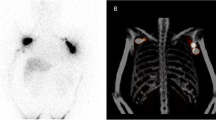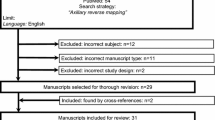Abstract
Background
Axillary reverse mapping (ARM) was developed to preserve the lymphatic drainage from the upper arm during sentinel lymph-node (SLN) biopsy or axillary lymph-node dissection (ALND). However, the oncological safety of ARM has been controversial because of not infrequent involvement of ARM nodes.
Methods
Patients with clinically negative nodes (cN0) underwent SLN biopsy and ARM. SLNs were identified using blue dye and radioisotope, and ARM nodes were traced using the fluorescent method. Patients with positive SLN underwent the standard ALND. After surgery, they were followed up for more than 3 years.
Results
A total of 507 patients with cN0 breast cancer were enrolled between May 2009 and November 2017. SLNs were identified in 499 (98%) of 507 patients, and ARM nodes were identified in 159 (31%) patients in the SLN field. The crossover rate of SLN–ARM nodes was 28%. Among 95 patients with positive SLNs, 70 patients underwent conventional ALND. ARM nodes were identified in 65 (93%) of those patients in the ALND field. The mean number of removed ARM nodes was 7.2 (range 0–25) in patients who underwent the standard ALND. Although ARM nodes were involved in 18 of 65 patients, the involved ARM nodes were the same SLNs identified in 14 (78%) patients. Since SLN–ARM nodes should be removed, ARM nodes were involved only in 4 (5.7%) patients after SLN biopsy.
Conclusions
Except for positive SLN–ARM nodes, the involvement of ARM nodes is infrequent in patients with positive SLN.

Similar content being viewed by others
References
Thompson M, Korourian S, Henry-Tillman R, Adkins L, Mumford S, Westbrook KC, et al. Axillary reverse mapping (ARM): a new concept to identify and enhance lymphatic preservation. Ann Surg Oncol. 2007;14:1890–5. https://doi.org/10.1245/s10434-007-9412-x.
Nos C, Lesieur B, Clough KB, Lecuru F. Blue dye injection in the arm in order to conserve the lymphatic drainage of the arm in breast cancer patients requiring an axillary dissection. Ann Surg Oncol. 2007;14:2490–6. https://doi.org/10.1245/s10434-007-9450-4.
Suami H, Taylor GI, Pan W-R. The lymphatic territories of the upper limb: anatomical study and clinical implications. Plast Reconstr Surg. 2007;119:1813–22. https://doi.org/10.1097/01.prs.0000246516.64780.61.
Pavlista D, Eliska O. Relationship between the lymphatic drainage of the breast and the upper extremity: a postmortem study. Ann Surg Oncol. 2012;19:3410–5. https://doi.org/10.1245/s10434-012-2363-x.
Noguchi M, Miura S, Morioka E, Ohno Y, Yokoi-Noguchi M, Nakano Y, et al. Is axillary reverse mapping feasible in breast cancer patients? Eur J Surg Oncol. 2015;41:442–9. https://doi.org/10.1016/j.ejso.2015.01.029.
Kang SH, Choi JE, Jeon YS, Lee SJ, Bae YK. Preservation of lymphatic drainage from arm in breast cancer surgery: is it safe? Cancer Res. 2009;69(suppl. 2):87s.
Deng H, Chen L, Jia W, Chen K, Zeng Y, Rao N, et al. Safety study of axillary reverse mapping in the surgical treatment for breast cancer patients. J Cancer Res Clin Oncol. 2011;137(12):1869–74. https://doi.org/10.1007/s00432-011-1064-3.
Noguchi M, Noguchi M, Ohno Y, Morioka E, Nakano Y, Kosaka T, et al. Feasibility study of axillary reverse mapping for patients with clinically node-negative breast cancer. Eur J Surg Oncol. 2016;42:650–6. https://doi.org/10.1016/j.ejso.2016.02.244.
Tummel E, Ochoa D, Korourian S, Betzold R, Adkins L, McCarthy M, et al. Does axillary reverse mapping prevent lymphedema after lymphadenectomy. Ann Surg. 2017;265(5):987–92. https://doi.org/10.1097/SLA.000000000001778.
Yuan Q, Wu G, Xiao SY, Hou J, Ren Y, Wang H, et al. Identification and preservation of arm lymphatic system in axillary dissection for breast cancer to reduce arm lymphedema events: a randomize clinical trial. Ann Surg Oncol. 2019;26:3446–544. https://doi.org/10.1245/s10434-019-07569-4.
Liu S, Wang N, Gao P, Liu P, Yang H, Xie F, et al. Using the axillary reverse mapping technique to screen breast cancer patients with a high risk of lymphedema. World J Surg Oncol. 2020;18:118. https://doi.org/10.1186/s12957-020-01886-9.
Giuliano AE, Ballman KV, McCall L, Beitsch P, Brennan MB, Kelemen P, et al. Effect of axillary dissection vs no axillary dissection on 10-year overall survival among women with invasive breast cancer and sentinel node metastasis: the ACOSOG Z0011 (Alliance) randomized clinical trial. JAMA. 2017;318(10):918–26. https://doi.org/10.1001/jama.2017.11470.
Gennaro M, Listorti C, Mariani L, Maccauro M, Bianchi G, Capri G, et al. Oncological safety of selective axillary dissection after axillary reverse mapping in node-positive breast cancer. Eur J Surg Oncol. 2021;47(7):1606–20. https://doi.org/10.1016/j.ejso.2020.10.031.
Lyman GH, Giuliano AE, Somerfield MR, Benson AB III, Bodurka DC, Burstein HJ, et al. American society of clinical oncology guideline Recommendations for sentinel lymph node biopsy in early-stage breast cancer. J Clin Oncol. 2005;23:7703–20. https://doi.org/10.1200/JCO.2005.08.001.
Greene FL, Page DI, Fleming ID, et al. AJCC cancer staging manual. 6th ed. New York: Springer; 2002. p. 223–40.
Donker M, van Tienhoven G, Straver ME, Meijnen P, van de Velde CJH, Mansel RE, et al. Radiotherapy or surgery of the axilla after s positive sentinel node in breast cancer (EORTC 10981–22023): a randomized, multicenter, open-label, phase 3 non-inferiority trial. Lancet Oncol. 2014;15:1303–10. https://doi.org/10.1016/S1470-2045(14)70460-7.
Schrenk P, Rieger R, Shamiyeh A, Wayand W. Morbidity following sentinel lymph node biopsy versus axillary lymph node dissection for patients with breast carcinoma. Cancer. 2000;88:608–14.
Sener SF, Winchester DJ, Martz CH, Feldman JL, Cavanaugh JA, Winchester DP, et al. Lymphedema after sentinel lymphadenectomy for breast carcinoma. Cancer. 2001;92(4):748–52. https://doi.org/10.1002/1097-0142(20010815)92:4%3c748::aid-cncr1378%3e3.0.co;2-v.
Wilke LG, McCall LM, Posther KE, Whitworth PW, Reintgen DS, Leitch AM, et al. Surgical complications associated with sentinel lymph node biopsy: results from a prospective international cooperative group trial. Ann Surg Oncol. 2006;13(4):491–500. https://doi.org/10.1245/ASO.2006.05.013.
Gross E, Hannoun-Levi JM, Rouanet P, Houvenaeghei G, Teissier E, Ellis S, et al. Evaluation of immediate breast reconstruction and radiotherapy: factors associated with complications. Cancer Radiother. 2010;14(8):704–10. https://doi.org/10.1016/j.canrad.2010.05.004.
Foster D, Choy N, Porter C, Ahmed S, Wapnir I. Axillary reverse mapping with indocyanine green or isosulfan blue demonstrate similar crossover rates to radiotracer identified sentinel nodes. J Surg Oncol. 2018;117:336–40. https://doi.org/10.1002/jso.24859.
Han C, Yang B, Zuo WS, Zheng G, Yang L, Zheng M. The feasibility and oncological safety of axillary reverse mapping in patients with breast cancer: a systemic review and meta-analysis of prospective studies. PLoS ONE. 2016;11(2):e0150285. https://doi.org/10.1371/journal.pone.0150285 (eCollection 2016).
Yoon KH, Lim SM, Koo B, Kim JY, Park HS, Park S, et al. Conserving the lymphatics from the arm using fluorescence imaging in patients with breast cancer at high risk of postoperative lymphedema: a pilot study. Gland Surg. 2020;9(3):629–36. https://doi.org/10.21037/gs.2020.03.29.
Sakurai T, Endo M, Shimizu K, Yoshimizu N, Nakajima K, Nosaka K, et al. Axillary reverse mapping using fluorescence imaging is useful for identifying the risk group of postoperative lymphedema in breast cancer patients undergoing sentinel node biopsies. J Surg Oncol. 2014;109(6):612–5. https://doi.org/10.1002/jso.23528.
Connor C, McGinness M, Mammen J, Ranallo L, Lafaver S, Klemp J, et al. Axillary reverse mapping: a prospective study in women with clinically node negative and node positive breast cancer. J Ann Surg Oncol. 2013;20(10):3303–7. https://doi.org/10.1245/s10434-013-3113-4.
Ollila DW, Hwang ES, Brenin DR, Kuerer HM, Yao K, Feldman S. The changing paradigms for breast cancer surgery: performing fewer and less-invasive operations. Ann Surg Oncol. 2018;25(10):2807–12. https://doi.org/10.1245/s10434-018-6618-z.
Montagna G, Mamtani A, Knezevic A, Brogi E, Barrio AV, Morrow M. Selecting node-positive patients for axillary downstaging with neoadjuvant chemotherapy. Ann Surg Oncol. 2020;27:4515–22. https://doi.org/10.1245/s10434-020-08650-z.
Funding
This study is funded by Eisai.
Author information
Authors and Affiliations
Contributions
MN: conceptualization, and writing—review and editing. MI: investigation. MN and EM: investigation.
Corresponding author
Additional information
Publisher's Note
Springer Nature remains neutral with regard to jurisdictional claims in published maps and institutional affiliations.
About this article
Cite this article
Noguchi, M., Inokuchi, M., Yokoi-Noguchi, M. et al. The involvement of axillary reverse mapping nodes in patients with clinically node-negative breast cancer. Breast Cancer 29, 209–215 (2022). https://doi.org/10.1007/s12282-021-01300-6
Received:
Accepted:
Published:
Issue Date:
DOI: https://doi.org/10.1007/s12282-021-01300-6




